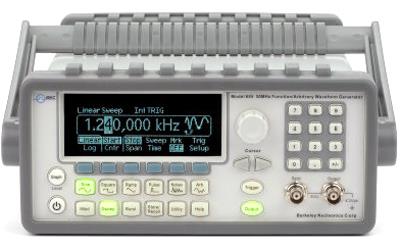
|
|
The BNC 645 50MHz Function/Arbitrary Waveform Generator delivers many advanced features and user modes. New DDS+ technology embraces advancements in the semiconductor industry and leverages state-of- the-art components for both standard and complex functions.
The Model 645 can generate variable-edge pulses at rates up to 10MHz. From the front panel or through remote communications, the user may vary the period, pulse width and amplitude. The pulse parameters may be stored in the unit or on your computer for later recall.
The BNC 645 offers 14-bit resolution and a 125 MSa/s sampling rate, giving users enough control of their waveforms for most applications. It will storage of up to 5 waveforms concurrently ( 4 waveforms (4 x 256K points) in nonvolatile memory and 1 waveform in volatile memory.
Specifications.
Capability.
Standard Wave forms: Sine, Square, Ramp, Triangle, Pulse, Noise, DC .
Built-in arbitrary waveforms: Exponential Rise and Fall, Negative ramp, Sin (x)/x, Cardiac.
Modulation Types: AM, FM, PM, FSK, PWM, Sweep and Burst.
Waveform Characteristics.
Sine
Frequency: 1 µHz 50 MHz.
Amplitude: 0.1 dB (< 100 KHz).
Flatness: 0.15dB (<5MHz).
Total Harmonic Distortion: DC to 20 KHz, Output ≥ 0.5Vpp THD+N ≤0.06%.
Square
Frequency: 1 µHz to 25 MHz .
Rise/ Fall time: < 10 ns .
Overshoot: < 2%.
Variable Duty Cycle: 20% to 80% (to 10MHz), 40% to 60% (to 25 MHz).
Asymmetry: 1% of period + 5 ns (@ 50% duty).
Ramp, Triangle
Frequency: 1 µHz to 200 KHz.
Linearity: < 0.1% of peak output.
Symmetry: 0.0% ~ 100.0%.
Noise
Bandwitdh: 20 MHz Typical.
Arbitrary
Frequency: 1 µHz to 10MHz.
Length: 2 to 256 K.
Resolution: 14 bits (Including sign).
Sample Rate: 125 MSa/s.
Min Rise/ Fall: 30 ns typical.
Linearity: < 0.1% of peak output.
Settling Time: <250 ns to 0.5% of final value.
Common Characteristics.
Frequency Resolution: 1µHz.
Amplitude Range: 10mVpp to 10Vpp in 50Ω, 20mVpp to 20 20Vpp in Hi-Z.
Amplitude Accuracy (at 1KHz): ±1% of setting ±1mVpp.
DC Offset Range (Peak AC + DC): ±2% of offset setting, ±0.5% of amplitude setting.
|